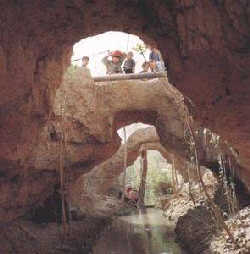| Curiosity > Landscape |
|
|
Karez - the Underground Canal
Karez is mainly distributed in Turpan, Hami and Helei districts in Xinjiang, where Turpan District is reputed as the place with the most karez (more than 1,000). The annual discharge of karez in Turpan totals 29.4 billion cubic meters, irrigating the vast farmlands in the region all year round. Linked together, the total length of these karez would exceed 5,000 kilometers. Thus, karez is also dubbed the "underground canal". The karez skillfully makes use of the geological conditions in the Turpan Basin, radiation from the sun and the atmosphere's circumfluence to form a unique underground irrigation system, representing the intelligence of Chinese people thousands of years ago. In the Turpan Basin, people dig perpendicular wells at regular intervals on the slopes of foothills and then link them up with tunnels to produce a network of underground channels. Into these channels flows subterranean water from high places on the mountains. Karez are largely built in the Turpan Basin due to the basin's unique natural
conditions. First of all, two major snow mountains, the Bogda Mountain and
Kalawucheng Mountain, are respectively located north and west to the basin.
Plenty of thawed snow and rainwater runs downhill from the mountains to the
basin around summertime, which is immediately infiltrated and soon becomes an
undercurrent. This undercurrent beneath the Gobi desert has grown very large and
strong, with a consistent water inflow year after year that has provided enough
water for the karez wells.
|
|||||
 |
